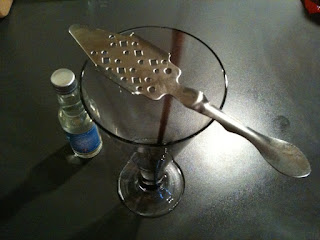Through
Fuelmyblog I've had the chance to sample some absinthe from
Absinthe-Shop. What's that got to do with language use and journalism? Well, I could mention the (tired) stereotype of
hard-drinking journalists, or talk about the connection between absinthe and writers such as Arthur Rimbaud and Guy de Maupassant. But really, I just wanted to try the absinthe.
What I got to sample was
La Clandestine, a Swiss 'la bleue' absinthe (which is neither blue, nor indeed green, but clear). It also came with a metal absinthe spoon:
Absinthe-Shop has this to say on the "traditional method" of preparing absinthe:
A 1 ounce / 30 ml measure (also known as a ‘dose’) of absinthe is poured into a glass. A flat, slotted spoon is placed across the rim of the glass and a sugar cube added on top of the spoon. Add — slowly — 3 to 5 parts iced water to the drink, pouring directly onto the sugar cube.
It emerges that in our modern society it is now harder to obtain sugar cubes than absinthe, so I had to use granulated sugar instead - which didn't work particularly well with the slotted absinthe spoon. (Talking of spoons, the next time you are in a greasy one, pocket a few sugar cubes. You never know when you might need them.)
Despite this hitch, the best part about drinking absinthe is
the ritual. It's up there with making a pot of tea or brewing coffee with a French press - except more boozy.
For my girlfriend Sarah, who also took part in this madcap endeavour, the best part is watching the absinthe change colour. It starts off clear:
Then, when the water is poured in, the drink turns opaque (and yes, magically transforms one glass into two):
This process is called the louche.
So I'd better talk about the taste. We tried the absinthe both with and without sugar because bleue absinthes often have a natural sweetness (I was told in the tasting notes). And actually, that turned out to be true - the absinthe was not at all bitter unsweetened. Sarah did find that "the sugar took away the alcoholic hit at the back of your throat".
Despite being promised an array of herbal flavours, all I could taste was anise - probably because of my undeveloped absinthe palate. Having said that, Sarah and I both found the absinthe surprisingly smooth, and we agreed that we would rather drink La Clandestine than ouzo, say, or Pernod.
Plus, you don't get to use a slotted spoon with any of those lesser anise-flavoured drinks.
And no, it didn't send me crazy.
Engine Room readers who want to buy absinthe or absinthe accessories get 10% off at Absinthe-Shop until 30 June. The offer excludes items already on sale or discounted. Input this voucher code into the box on the My Cart page to apply: FMBLUV10





